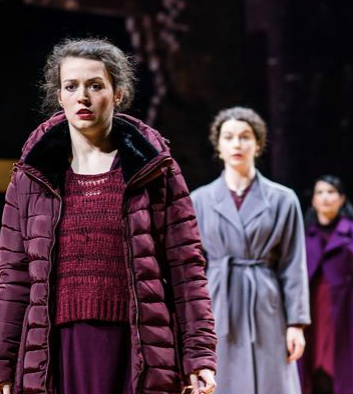[Written by Anna Rieser]
[Image Credit: the Citizens Theatre]
Stef Smith’s version of A Dolls House brings together three generations of women as the same character, to show how the original dilemma of Henrik Ibsen’s Nora plays out at different ages.
The different versions of Nora we encounter are found in critical years for women’s rights. In 1918, Molly Vever’s version enjoys the right to vote for the first time, Maryam Hamidi’s Nora occupies a world where abortion, the pill and homosexual relationships are legal in 1968. Finally, in 2018, Anna Russell-Martin’s Nora lives in a world where #MeToo has gained traction and drawn attention to the problems women have encountered for centuries. Despite these seminal moments for feminism, Nora is still experiencing stifling oppression in her own home, using her charm to wheedle permission from her husband Thomas (Tim Barrow). He encourages her wheedling, calling her ‘my little lark’, as he teases and treats her like a child. What strikes you throughout the production is how normal this dynamic is; 140 years after Ibsen’s play was originally performed, the interactions between husband and wife still ring true.
Each Nora has her vice to take the edge off, a forbidden treat that is hers and hers alone; whether sugar, pills, or a small bottle of cheap liquor, they keep these close to their chests as the claustrophobic environment of the house, economic realities and a stifling relationship bear down on them. The three women pass parts to each other deftly, each occupying both Christine and Nora’s roles through the simple exchange of a scarf. Tom Piper’s set design lends itself to dancing around the stage, a square with only outlines of doors and windows that allow maximum movement and imagination into the homes of these women.
The performance of each Nora is different enough to make it feel like she could be any woman put in this circumstance. Each of the women holds the ability to charm, but each brings a different tone, accent and physicality to the part. What could have been a gimmick of weaving three stories into one, plays out as a beguiling testimony to the continuation of patriarchy. However, Barrow’s performance as her husband Thomas is villainous in a way that feels a little out of kilter with the rest of the play. There is an unctuousness that is more stagey than the naturalism of the rest of the cast, so that he becomes a one-dimensional foil to her triple fleshed character.
At the heart of the play is a loan that highlights the economic disadvantage of women, whether through their inability to obtain credit, or the fact that domestic and reproductive labour is unpaid to this day. Nora’s realisation of her inability to continue in this paradigm plays out in different ways across the ages, but retains the shock factor that saw audiences of the original faint as she chooses her duty to herself, over that of to her husband or children.
In an interview with The Scotsman, the writer Steph Smith said that her aim with this production was to use Ibsen’s ability to demonstrate “profound insight into people’s private emotional worlds, their ultimate loneliness and isolation”, and to “make just one person in the audience feel a little less alone on the journey they’re on.” In the interval, I spoke to several women who were feeling just that; we are not all Nora, but there are threads within her life that are as recognisable in 2019 as 1879.

